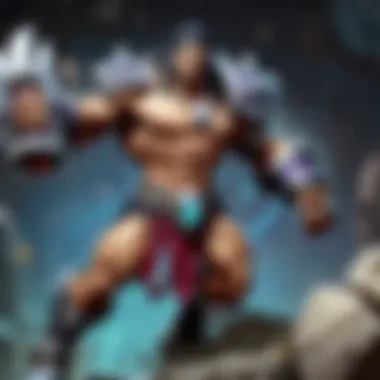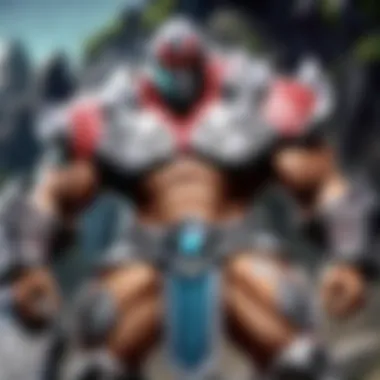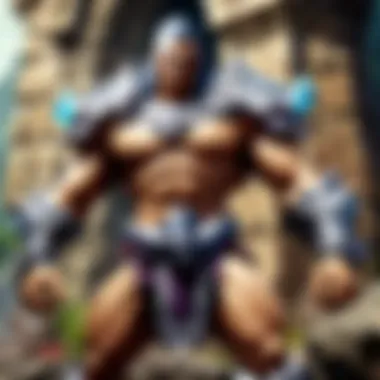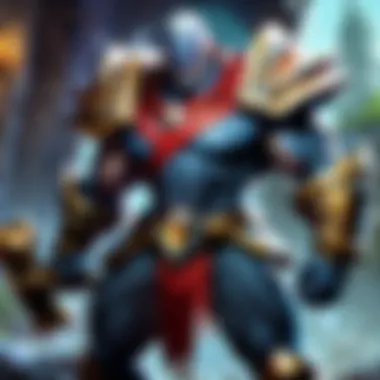Exploring Stone Skin: Origins, Mechanics, and Impact


Intro
In the world of League of Legends, the term stone skin carries significant weight, referring to a unique defensive characteristic exhibited by certain champions. This article seeks to unpack the origins and mechanics behind stone skin, revealing how it impacts gameplay on various levels. From the historical significance of this term to its manifestations in champion abilities, understanding stone skin is crucial for both seasoned veterans and newcomers eager to grasp the complexities of the game.
Stone skin is more than just a stat; it encapsulates a philosophy of resilience and strategic interaction. Many players equate the term with a formidable shield against both physical and magical damage, allowing for aggressive positioning and tactical plays in battles. By examining its origins, players can gain insight into how this concept evolved in conjunction with the game's growth.
Champion Spotlights
Analysis of Champions with Stone Skin
Champion design in League of Legends often incorporates diverse abilities that enhance gameplay dynamics. Stone Skin is predominantly found in characters who embody durability, allowing them to thrive in skirmishes and team fights.
Several champions exemplify this attribute:
- Malphite: Known for his towering presence on the battlefield, Malphite's abilities allow him to absorb damage effectively, making him a cornerstone in many team compositions. His immunity to slow effects enables aggressive plays, punishing opponents who misposition.
- Gragas: While not solely defined by stone skin, Gragas's kit offers substantial tankiness. His body slam ability provides both mobility and a grappling point in gameplay, serving well in chaotic encounters.
- Garen: As a champion, Garen utilizes stone skin effectively, especially after the introduction of his updated abilities. His capacity to sustain in battles is enhanced by his innate tankiness, making him a vital asset during team engagements.
New Champion Spotlight
The release of new champions often reshapes gameplay dynamics. When Riot Games introduces a new character with stone skin attributes, it invites players to reassess existing strategies. For instance, the latest champion updates might feature mechanics that allow players to mitigate burst damage while encouraging aggressive tactics.
Gameplay Tips and Strategies
Early Game Tactics
During the early phases, controlling vision and jungle pressure is crucial. Champions with stone skin can often engage more frequently with foes due to their natural resilience. Players should focus on the following strategies:
- Secure river vision before making aggressive plays.
- Utilize your tankiness to zone opponents from objectives like dragons or buffs.
- Trade intelligently as stone skin champions, often coming out favorable in 1v1 encounters.
Team Fighting Strategies
In team fights, champions equipped with stone skin can absorb substantial damage, allowing their teammates to focus on damage output. Here are some strategies to optimize team fights:
- Prioritize the frontline: Utilize your stone skin champions to initiate fights, absorbing enemy damage.
- Communicate with teammates about your absorption capabilities, ensuring they position accordingly to maximize damage output.
- Use ultimates effectively, ensuring that your presence can disrupt enemy formations and capitalize on the additional damage absorption.
Patch Updates
Patch Notes Analysis
With each patch, balance changes alter the landscape of competitive play. Detailed analysis of patch notes focusing on stone skin impacts can unveil evolving trends in champion effectiveness. For instance, subtle tweaks in resistances or cooldowns can greatly affect gameplay viability.
Meta Shifts
The introduction of new items or champions often leads to meta shifts. Observing how stone skin champions adjust to these changes can be critical for players aiming to adapt their strategies and builds accordingly.
The End
Preamble to Stone Skin
Stone skin represents a significant concept that influences both the lore and mechanics of League of Legends. Understanding its implications is crucial for players who seek to deepen their grasp of the game. This section lays the foundation for the subsequent discussion on stone skin, examining its definition, historical background, and gameplay relevance. Essential as it is, stone skin adds layers to the strategic depth of champion interactions.
Defining Stone Skin
Stone skin is primarily understood as a defensive mechanic that enhances a champion's durability. In practice, it may manifest as damage reduction or resistance to crowd control, enabling certain champions to withstand significant attacks. This term encompasses different functionalities which can diverge significantly between champions. For instance, Gragas may use it to mitigate burst damage, while champions like Alistar benefit from its protective qualities during team fights. Grasping how stone skin operates allows players to leverage their chosen champions effectively, adapting their playstyle to maximize benefits in various situations.


Historical Context
The origin of stone skin as a concept can be traced to earlier iterations of League of Legends, where champions often required mechanics that provided a balance between offense and defense. This development led to diverse champion designs featuring unique attributes. Historical analysis reveals a trend toward creating tankier champions capable of withstanding intense combat scenarios, especially in the late-game stages. Additionally, lore plays a role in the character backgrounds that integrate stone skin, portraying these champions as resilient figures, often linked to themes of endurance and strength. Understanding this context enriches the overall gaming experience, as it connects gameplay mechanics with narrative elements.
Relevance in Gameplay
In gameplay terms, stone skin affects strategic decision-making. Champions with stone skin can change the dynamics of fights and influence team strategies. For instance, players might choose champions with stone skin for specific roles based on their capability to disrupt enemy patterns. Furthermore, the existence of stone skin within the game steers counter-play options, prompting teams to devise compositions that either leverage or mitigate its effectiveness. Players who comprehend this relevance can better anticipate enemy movements and adjust accordingly, which is key to mastering League of Legends.
"Stone skin not only enhances character survival but also reshapes gameplay strategies for teams. It is an essential aspect of champion design that players must understand to gain a competitive advantage."
Acquiring a deep understanding of stone skin sets the stage for exploring its mechanics, champion-specific usages, and the broader implications on gameplay, further highlighted in the following sections.
The Mechanics of Stone Skin
Understanding the mechanics of Stone Skin is essential for both players and developers of League of Legends. This feature significantly shapes gameplay experiences, influencing champions' efficacy during matches. Stone Skin is not merely a defensive mechanism; it is an intricate blend of statistics, damage mitigation, and interaction with other abilities. Therefore, players must grasp its unique attributes to fully leverage it in their strategies.
Statistical Characteristics
Statistical characteristics of Stone Skin revolve around how it influences a champion's overall resilience in battles. In terms of numerical values, champions with Stone Skin typically exhibit an increase in defensive stats against damage sources. These champions can sustain more damage before succumbing in fight scenarios. The exact numbers may differ depending on patch updates or balance changes, but the core essence remains consistent.
- Increased Armor and Magic Resistance: This affects both basic and percentage-based damage.
- Scaling Potential: Often, the effectiveness of Stone Skin may improve as the game progresses, making champions harder to take down in late-game phases.
Damage Reduction Effects
Damage reduction effects are crucial when considering how Stone Skin performs in actual game play. The impact can vary based on the type and source of damage faced by the champion. A significant attribute is its ability to counter specific forms of damage, leading to different strategic outcomes. The layer of damage reduction provided by Stone Skin can lead to unique interactions during team fights.
"Champions with Stone Skin can withstand damage that would easily drop others, encouraging aggressive strategies."
- Flat Damage Reduction: This provides a buffer against immediate damage.
- Proportional Damage Reduction: This signifies that the effectiveness can scale depending on the total health of a champion.
Interaction with Abilities
The interaction of Stone Skin with abilities offers another layer of strategy to explore. Some champions can enhance their defenses further by intelligently timing their ability usage. Abilities may provide additional bonuses that work well with Stone Skin, allowing champions to redirect damage effectively.
- Synergies with Shielding Abilities: When combined with shields, Stone Skin offers enhanced survivability.
- Cleansing Negative Effects: Certain characters may use Stone Skin to remove or counteract crowd-control effects, therefore maintaining presence in battles.
Players need to analyze these interactions closely. Understanding how Stone Skin fits into the broader mechanics of a champion leads to better decision-making on the field.
Through these mechanics, Stone Skin stands as a unique game element, enriching both gameplay experiences and strategic depth in League of Legends.
Champion Profiles Featuring Stone Skin
The presence of stone skin in certain champions significantly shapes their role within the game and their overall effectiveness in various situations. This dynamic property not only provides durability but also influences strategies for both the players who control such champions and those who confront them. The exploration of champion profiles featuring stone skin allows players to gain insights into the design philosophy and gameplay implications surrounding these unique characters.
Notable Champions with Stone Skin
Several champions within League of Legends embody the concept of stone skin. These champions utilize this mechanic to enhance their survivability and provide valuable support to their teams. Among them are champions like Malphite, Ryze, and Braum. Each brings something different to the table:
- Malphite is known for his ability to absorb damage while initiating team fights, often serving as a pivotal front-line presence.
- Ryze leverages stone skin to remain resilient during sustained engagements, facilitating his role as both damage dealer and spell caster.
- Braum can shield allies while benefiting from the resilience that stone skin provides, enhancing team synergy.
These champions exemplify how stone skin impacts gameplay, strategy, and player decisions.
The Role of Stone Skin in Champion Design


The design of champions with stone skin is deliberate and founded on specific gameplay intentions. The ability to withstand significant damage allows these champions to engage enemies more effectively while soaking up incoming attacks. This leads to innovative design choices that favor tank-like behavior but with distinct abilities that differentiate each champion.
Moreover, champions like Gragas showcase versatility, as they can utilize stone skin to fulfill multiple roles in a team composition. The programming behind such designs ensures that the champions have clear gameplay roles while maintaining engagement. In essence, stone skin helps to define a champion's identity, making them attractive choices in gameplay.
Player Experiences with Stone Skin Champions
Players have varying experiences when controlling champions with stone skin. While many enjoy the robustness these champions bring, others note the challenges they face in maximizing their potential. Success with a stone skin champion is often contingent on understanding their kit and positioning.
- Tankiness: Players generally appreciate the damage mitigation aspect, enabling them to dive into fights without immediate fear of elimination.
- Positioning: However, strategic positioning can be a hurdle. Players must learn how to effectively engage while protecting vulnerable allies.
- Community Feedback: The community feedback on skin champions is insightful. Platforms such as reddit.com contain a wealth of personal stories and gameplay discussions, shedding light on the nuances of playing these champions.
In summary, stone skin not only characterizes specific champions but also impacts the overall gameplay experience in League of Legends. Understanding the profiles of champions that utilize this mechanic enhances one's capability to adapt strategies and form team dynamics, ultimately leading to improved performance.
Implications for Gameplay Strategy
The significance of stone skin in gameplay strategy is multi-faceted. Recognizing the mechanics behind the stone skin ability can fundamentally alter how players approach their matches. This understanding is essential for both offense and defense and can lead to more effective team compositions and tactical decisions during gameplay.
Understanding Counterplay Dynamics
Counterplay involves anticipating an opponent's actions and adapting strategies accordingly. When facing champions with stone skin abilities, players must approach their tactics with caution. The damage reduction properties of stone skin allow these champions to absorb significant amounts of damage. Thus, it is crucial for opposing players to consider champions or abilities that can penetrate this defensive capability. For instance, utilizing champions with true damage, or abilities that ignore shields, can be impactful against stone skin champions. Moreover, strategic coordination can also help in dealing with these champions. Teams might opt for crowd controls or overpowering burst damage combos to counteract the advantages provided by stone skin.
Team Composition Considerations
Character selection plays a vital role in optimizing a team’s effectiveness against stone skin champions. When building a team composition, players should identify the stone skin champions present on the enemy team and tailor their picks accordingly. A balanced team should include champions that can deal with high durability opponents while still maintaining the offensive threat.
- Diversity in Damage Types: Including both magic and physical damage sources helps in preventing stone skin from nullifying all damage effectively. It can create pressure on the stone skin champions to adapt.
- Synergy with Crowd Control: Champions that excel in crowd control can limit the movement and actions of stone skin users, making it easier for teammates to apply pressure. This synergy is crucial in ensuring that the opponent cannot fully utilize their stone skin advantage.
- Sustain and Mobility: Compositions that incorporate healing or mobility can also provide an edge. If a team can sustain its members through heavy damage, they can mitigate the effects of stone skin during engagements.
Optimal Engagement Tactics
In practical application, the setup for optimal engagement against stone skin champions is paramount. Players should prioritize tactical positioning and timing when engaging. Positions that allow for flanking can create opportunities to isolate and overwhelm stone skin champions before they can utilize their advantages. Below are key tactics to employ:
- Initiation Timing: Choose the moment to engage carefully. Engaging when the enemy is over-extended can lead to isolating stone skin champions from their supports.
- Target Focus: Prioritizing targets based on their current health status and abilities can maximize damage output and reduce effectiveness of stone skin effects.
- Engagement Zones: Controlling the battlefield is also essential. Ensuring the fight occurs in tight spaces can limit the escape options for stone skin users while amplifying the effectiveness of team abilities.
Understanding the nuances of stone skin provides players with strategic advantages that can greatly influence the outcome of matches in League of Legends. By studying opponent compositions and adapting accordingly, players can leverage the strengths and weaknesses of stone skin to their benefit.
Community Interpretation of Stone Skin
Understanding how the community interprets Stone Skin is crucial for grasping its larger role within League of Legends. This characteristic does not exist in isolation; it reflects broader themes in gameplay, champion design, and player engagement. Community feedback on Stone Skin offers valuable insights into perceptions and strategies, as well as potential areas for development within the game. A close look at community reactions and discussions reveals how Stone Skin influences player behavior and decision-making.
Feedback and Reactions Across Platforms
Community feedback serves as a barometer for how well Stone Skin is perceived by players. On reddit and gaming forums, discussions often center on the effectiveness of champions with this feature. Players frequently express opinions about how Stone Skin affects their gameplay experience. Feedback can range from valuing the strategic advantages provided by tanky champions to criticism regarding perceived overpowered interactions.
Some players argue that champions with Stone Skin have a significant place in the competitive scene, often acting as key frontline tanks. Others contend that this can disrupt balance within the game, leading to frustrating encounters. This duality in opinion highlights the ongoing conversation about balance and strategy.
- Positive Feedback
- Negative Feedback
- "I love how Stone Skin helps me soak damage for my team!"
- "It really makes some champions feel invulnerable during fights."
- "Champions with Stone Skin feel too strong right now."
- "It makes matchups feel unbalanced."
Both sides contribute to an evolving narrative around Stone Skin, reinforcing its significance in the community.
Influence of Streamers and Content Creators


Streamers and content creators play a pivotal role in shaping perceptions of Stone Skin. They often showcase gameplay that highlights the strengths and mechanics of champions featuring this ability. By demonstrating effective tactics or counterplay methods, they educate their audiences and inform community discussions.
Popular streamers like Tyler1 or Faker often attract large audiences when playing champions with Stone Skin. Viewers are able to see firsthand how these champions perform in different situations. Their commentary and analysis provide insights that can influence the community's understanding and approach toward gameplay involving Stone Skin.
This visibility helps drive trends, often shaping meta strategies based on player experiences shared through videos and live streams. As a result, players are more inclined to experiment with Stone Skin champions, fostering a continuous evolution in gameplay tactics.
Meta Evolution Influenced by Stone Skin
The impact of Stone Skin on the game meta is significant. Champions with this feature often dominate not just in popularity but also in effectiveness. As community preferences shift, so do champion selections in competitive play. Patch updates usually bring changes that can affect Stone Skin—both directly and indirectly—leading to a cycle of adaptation.
- Current Trends
- Champions like Malphite and Leona have seen increased play due to their robust use of Stone Skin.
- Their kit allows players to engage actively, leading to favorable outcomes in team fights.
As players grow accustomed to facing these champions, counter strategies develop, also influenced by feedback and discussions across platforms. This dynamic nature of the meta makes the community's interpretations and reactions highly relevant, as they dictate how champions with Stone Skin are integrated into the broader game experience.
Future Developments Regarding Stone Skin
Understanding the future of stone skin is critical for players navigating League of Legends' ever-shifting landscape. The game's mechanics and character abilities are regularly updated through patches and revisions. Such changes can significantly affect how stone skin functions and its overall impact on gameplay. Insights into these developments can help players adapt their strategies and optimize their gameplay.
Potential Changes in Upcoming Patches
The League of Legends development team frequently evaluates existing mechanics, striving to balance gameplay while enhancing player experience. Stone skin, being a crucial characteristic, is likely to see adjustments in upcoming patches. These could involve alterations to the damage reduction values or modifications to how stone skin interacts with crowd control effects.
“Balancing hero abilities is essential to ensure fair play and maintain engagement.”
Moreover, innovative champions are being released regularly. New champions might introduce alternate forms of stone skin or even completely novel mechanics. Players should keep an eye on patch notes and experimental changes on the Public Beta Environment (PBE) to understand how these adjustments will alter interactions in gameplay.
Predictions for Stone Skin's Role in Future Gameplay
As the meta evolves in League of Legends, the role of stone skin will likely change with it. Players might begin to see increased importance placed on characters with this ability, especially if they are reworked or receive new items that synergize well.
In future patches, the developers may enhance stone skin's attributes, causing players to incorporate these champions into their strategies more frequently. This could lead to an increased prevalence of stone skin champions in team compositions, affecting overall strategic planning in both casual and competitive settings.
The community’s growing understanding of stone skin’s mechanics will also influence its role in the game. As players dissect champion interactions and find synergies, we can expect an uptick in tactical plays that revolve around stone skin, thus embedding it deeper into competitive gameplay.
Community Initiatives and Suggestions
The League of Legends community plays a vital role in shaping the game’s future through feedback and suggestions. There are various forums and platforms where players can discuss stone skin and its implications. Websites like Reddit and the official League of Legends forums are valuable resources for players to voice their opinions and suggest changes.
Engagement with content creators and streamers also provides insights into community sentiment regarding stone skin. Many players connect through social media platforms such as Facebook to exchange thoughts on recent patches and share their experiences with champions featuring stone skin.
Furthermore, Riot Games often monitors these discussions and considers community suggestions when developing future updates. This symbiotic relationship between players and developers ensures that the game evolves to meet player expectations while maintaining a balanced environment.
The End
The conclusion of the article serves a crucial role in summarizing the insights discussed and emphasizing the significance of stone skin within League of Legends. This concept is not merely a term used for a defensive mechanic; it represents a strategic framework that influences gameplay at many levels.
Summary of Key Points
In reviewing the discussion, several key points emerge:
- Historical Origins: The concept of stone skin originated from various gaming mechanics and mythology, finding a unique place in League of Legends.
- Mechanics Involved: The statistical characteristics of stone skin, including damage reduction and interactions with abilities, form a foundational understanding of its application.
- Champion Profiles: The champions that utilize stone skin showcase diverse advantages, highlighting the role of this mechanic in both their design and gameplay.
- Strategic Implications: Players must understand counterplay dynamics, team compositions, and optimal engagement tactics when facing opponents with stone skin.
- Community Interpretation and Future: The ongoing dialogue within the community, fueled by content creators and patch updates, reflects evolving interpretations and adaptations of stone skin.
Final Thoughts on Stone Skin's Impact
Stone skin impacts not just individual champions but the strategic meta as a whole. Its presence encourages players to adapt and rethink their tactics regularly. With every update, the influence of stone skin can change, prompting players to stay informed and agile. Understanding this mechanic deeply is essential for players aspiring to enhance their gameplay. The interaction of stone skin with team dynamics, champion roles, and adaptive strategies makes it a vital subject for both novices and seasoned players alike.
In summary, stone skin represents a nuanced layer of gameplay that offers both challenges and opportunities, reinforcing the complexity of League of Legends as a competitive arena.







